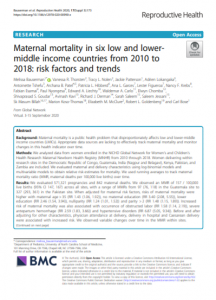
Background
Maternal mortality is a public health problem that disproportionately affects low and lower-middle income countries (LMICs). Appropriate data sources are lacking to effectively track maternal mortality and monitor changes in this health indicator over time.
Methods
We analyzed data from women enrolled in the NICHD Global Network for Women’s and Children’s Health Research Maternal Newborn Health Registry (MNHR) from 2010 through 2018. Women delivering within research sites in the Democratic Republic of Congo, Guatemala, India (Nagpur and Belagavi), Kenya, Pakistan, and Zambia are included. We evaluated maternal and delivery characteristics using log-binomial models and multivariable models to obtain relative risk estimates for mortality. We used running averages to track maternal mortality ratio (MMR, maternal deaths per 100,000 live births) over time.
Results
We evaluated 571,321 pregnancies and 842 maternal deaths. We observed an MMR of 157 / 100,000 live births (95% CI 147, 167) across all sites, with a range of MMRs from 97 (76, 118) in the Guatemala site to 327 (293, 361) in the Pakistan site. When adjusted for maternal risk factors, risks of maternal mortality were higher with maternal age > 35 (RR 1.43 (1.06, 1.92)), no maternal education (RR 3.40 (2.08, 5.55)), lower education (RR 2.46 (1.54, 3.94)), nulliparity (RR 1.24 (1.01, 1.52)) and parity > 2 (RR 1.48 (1.15, 1.89)). Increased risk of maternal mortality was also associated with occurrence of obstructed labor (RR 1.58 (1.14, 2.19)), severe antepartum hemorrhage (RR 2.59 (1.83, 3.66)) and hypertensive disorders (RR 6.87 (5.05, 9.34)). Before and after adjusting for other characteristics, physician attendance at delivery, delivery in hospital and Caesarean delivery were associated with increased risk. We observed variable changes over time in the MMR within sites.